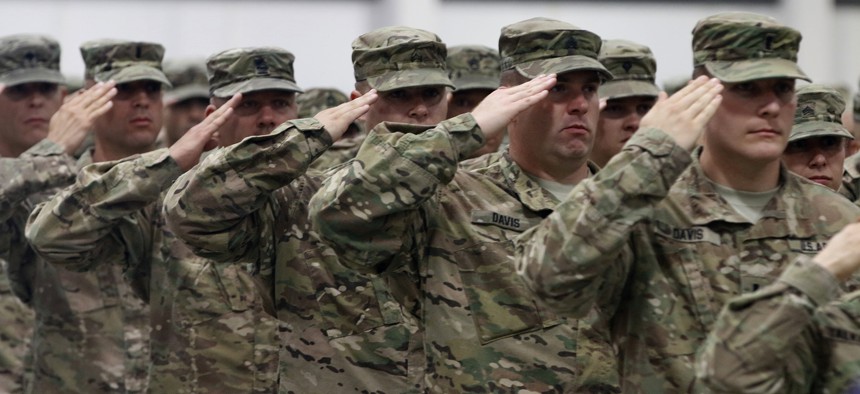
Soldiers from 2nd Battalion, 162nd Infantry Regiment, Oregon Army National Guard, render a salute during the National Anthem at their demobilization ceremony in Albany, Oregon, June 13, 2017. U.S. Army/Christopher L. Ingersoll
The US Army’s in Good Shape, But Tough Choices Loom
Some 500 programs are being scrutinized for cuts to support top acquisition priorities.
Good things are happening in the U.S. Army; we just need to make certain they continue.
For the first time in a decade, the Army’s fiscal year started on Oct. 1 with a full-year budget and authorization signed into law. The budget includes $14.8 billion to replace and upgrade current Army equipment, $3 billion for equipment repairs, and money to continue growing the size of the force.
The Army is also benefiting from renewed adoption of common goals, not just in the National Defense Strategy and Army Vision statement released earlier this year, but also with a pledge among the top leaders to hold fast against the inevitable attempts to amend the Army’s top modernization priorities. That promise to stick together despite outside pressure is vital to success.
The Army’s Total Force Policy has existed since 1973, but only in the last few years has it truly felt that way. As one whose Army service began in 1973 at the dawn of the all-volunteer Army and the Total Force Policy, I saw times when the Regular Army, Army National Guard and Army Reserve worked together as one seamless team and times when they didn’t, largely due to resource allocations that pitted one component against the other. While challenges still exist, significant progress has been made toward building one Army, a seamless team capitalizing on the essential roles of active-duty and reserve component soldiers as well as the indispensable role of Army civilians.
Related: US Army to Up-Armor Two More Brigades
Related: How A Human Resources System Could Revolutionize the Army
Related: The US Military Must Lighten Warfighters’ Loads
Our chief concern remains the budget. Increases in defense spending last year and this, combined with Congress’ timely enactment of the fiscal year 2019 appropriation, are important, though historically isolated successes. Without modification, defense spending caps return with the 2020 budget, squeezing the flow of money to the Army and increasing competition for fewer defense dollars. Congress must find a way to avoid the devastating, mindless, across-the-board funding cuts that will occur absent affirmative action. At the minimum, another two-year bipartisan budget agreement should be a high-priority task for the next Congress.
Former Army Chief of Staff Gordon R. Sullivan, my predecessor at the Association of the United States Army, was fond of saying, “Hope is not a method.” So preparations are being made for a cash-constrained Army future. In a plan certain to spark controversy and certain to require our support, Army leaders—Secretary Mark T. Esper and Chief of Staff Gen. Mark A. Milley—reviewed 500 Army programs looking for places to trim so they’d have enough money in the 2020-and-beyond budgets to pay for the capabilities improvements they know are so vital to future warfighting.
Their yet-to-be announced budgetary triage has looked to reduce or eliminate funding for programs that don’t align with the modernization priorities or where the Army can accept a little more risk. These cuts, essential to the Army’s future, are certain to be controversial and subject to second-guessing, particularly from industry and congressional supporters. Army leaders aren’t infallible, so the resource decisions ought to be discussed openly. But we can’t overlook the goal, which is making certain the Army can afford the force it needs for the future.
Cutting is hard and avoiding tough choices is easy, which makes this a remarkable time for the Army.
We also need to be concerned about manning the force now and in the future. Missing the 2018 recruiting goal by more than 6,000 people isn’t a disaster, because the Army made the right choice not to lower quality standards to fill the ranks, and because retention of highly qualified soldiers was higher than expected. However, it reinforces the valuable role that Army veterans like me can play in spreading the word about the value and reward of military service.
Sharing our experiences with others, especially service-aged youths, their families, coaches, teachers and community leaders, is a way of increasing the likelihood that military service is considered as one viable option among the many paths someone can take after high school. A few well-told stories about what you did when you were in the Army and how you grew professionally and as a citizen through the service could be a factor in how the Army gets the right person in the right place in the future.
America’s Army is strong. Those of us who have been privileged to wear the Army uniform still have a role to play. We are Soldiers for Life.



